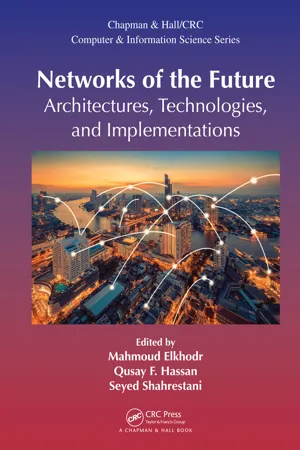
Networks of the Future
Architectures, Technologies, and Implementations
- 492 pages
- English
- ePUB (mobile friendly)
- Available on iOS & Android
Networks of the Future
Architectures, Technologies, and Implementations
About This Book
With the ubiquitous diffusion of the IoT, Cloud Computing, 5G and other evolved wireless technologies into our daily lives, the world will see the Internet of the future expand ever more quickly. Driving the progress of communications and connectivity are mobile and wireless technologies, including traditional WLANs technologies and low, ultra-power, short and long-range technologies. These technologies facilitate the communication among the growing number of connected devices, leading to the generation of huge volumes of data. Processing and analysis of such "big data" brings about many opportunities, as well as many challenges, such as those relating to efficient power consumptions, security, privacy, management, and quality of service. This book is about the technologies, opportunities and challenges that can drive and shape the networks of the future.
Written by established international researchers and experts, Networks of the Future answers fundamental and pressing research challenges in the field, including architectural shifts, concepts, mitigation solutions and techniques, and key technologies in the areas of networking. The book starts with a discussion on Cognitive Radio (CR) technologies as promising solutions for improving spectrum utilization, and also highlights the advances in CR spectrum sensing techniques and resource management methods.
The second part of the book presents the latest developments and research in the areas of 5G technologies and Software Defined Networks (SDN). Solutions to the most pressing challenges facing the adoption of 5G technologies are also covered, and the new paradigm known as Fog Computing is examined in the context of 5G networks.
The focus next shifts to efficient solutions for future heterogeneous networks. It consists of a collection of chapters that discuss self-healing solutions, dealing with Network Virtualization, QoS in heterogeneous networks, and energy efficient techniques for Passive Optical Networks and Wireless Sensor Networks. Finally, the areas of IoT and Big Data are discussed, including the latest developments and future perspectives of Big Data and the IoT paradigms.
Frequently asked questions
Information
Part I
Cognitive Radio Networks
1 Cognitive Radio with Spectrum Sensing for Future Networks
CONTENTS
1.1 INTRODUCTION AND BACKGROUND
Table of contents
- Cover
- Half Title
- Series Page
- Title Page
- Copyright Page
- Contents
- Preface
- Acknowledgments
- Reviewers
- Editors
- Contributors
- Part I Cognitive Radio Networks
- Part II 5G Technologies and Software-Defined Networks
- Part III Efficient Solutions for Future Heterogenous Networks
- Part IV Big Data and the Internet of Things
- Index